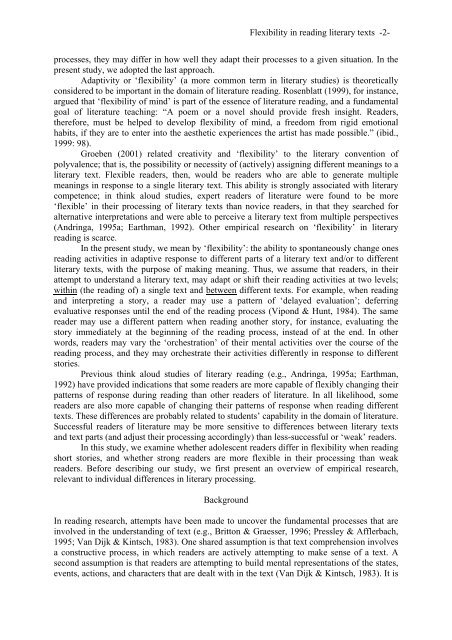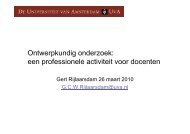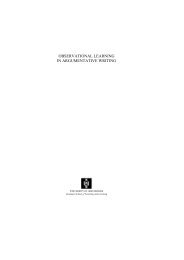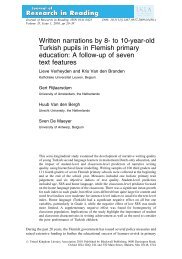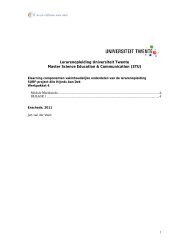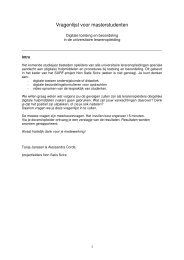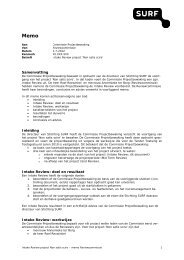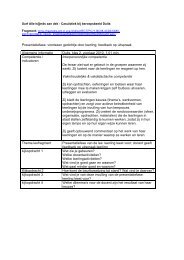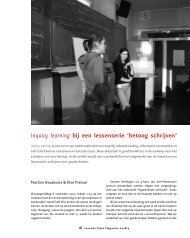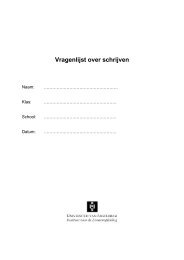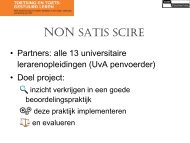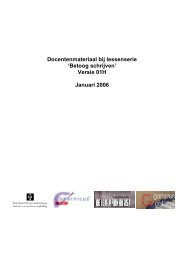Adaptivity in reading literary texts;
Adaptivity in reading literary texts;
Adaptivity in reading literary texts;
Create successful ePaper yourself
Turn your PDF publications into a flip-book with our unique Google optimized e-Paper software.
Flexibility <strong>in</strong> read<strong>in</strong>g <strong>literary</strong> <strong>texts</strong> -2-<br />
processes, they may differ <strong>in</strong> how well they adapt their processes to a given situation. In the<br />
present study, we adopted the last approach.<br />
<strong>Adaptivity</strong> or ‘flexibility’ (a more common term <strong>in</strong> <strong>literary</strong> studies) is theoretically<br />
considered to be important <strong>in</strong> the doma<strong>in</strong> of literature read<strong>in</strong>g. Rosenblatt (1999), for <strong>in</strong>stance,<br />
argued that ‘flexibility of m<strong>in</strong>d’ is part of the essence of literature read<strong>in</strong>g, and a fundamental<br />
goal of literature teach<strong>in</strong>g: “A poem or a novel should provide fresh <strong>in</strong>sight. Readers,<br />
therefore, must be helped to develop flexibility of m<strong>in</strong>d, a freedom from rigid emotional<br />
habits, if they are to enter <strong>in</strong>to the aesthetic experiences the artist has made possible.” (ibid.,<br />
1999: 98).<br />
Groeben (2001) related creativity and ‘flexibility’ to the <strong>literary</strong> convention of<br />
polyvalence; that is, the possibility or necessity of (actively) assign<strong>in</strong>g different mean<strong>in</strong>gs to a<br />
<strong>literary</strong> text. Flexible readers, then, would be readers who are able to generate multiple<br />
mean<strong>in</strong>gs <strong>in</strong> response to a s<strong>in</strong>gle <strong>literary</strong> text. This ability is strongly associated with <strong>literary</strong><br />
competence; <strong>in</strong> th<strong>in</strong>k aloud studies, expert readers of literature were found to be more<br />
‘flexible’ <strong>in</strong> their process<strong>in</strong>g of <strong>literary</strong> <strong>texts</strong> than novice readers, <strong>in</strong> that they searched for<br />
alternative <strong>in</strong>terpretations and were able to perceive a <strong>literary</strong> text from multiple perspectives<br />
(Andr<strong>in</strong>ga, 1995a; Earthman, 1992). Other empirical research on ‘flexibility’ <strong>in</strong> <strong>literary</strong><br />
read<strong>in</strong>g is scarce.<br />
In the present study, we mean by ‘flexibility’: the ability to spontaneously change ones<br />
read<strong>in</strong>g activities <strong>in</strong> adaptive response to different parts of a <strong>literary</strong> text and/or to different<br />
<strong>literary</strong> <strong>texts</strong>, with the purpose of mak<strong>in</strong>g mean<strong>in</strong>g. Thus, we assume that readers, <strong>in</strong> their<br />
attempt to understand a <strong>literary</strong> text, may adapt or shift their read<strong>in</strong>g activities at two levels;<br />
with<strong>in</strong> (the read<strong>in</strong>g of) a s<strong>in</strong>gle text and between different <strong>texts</strong>. For example, when read<strong>in</strong>g<br />
and <strong>in</strong>terpret<strong>in</strong>g a story, a reader may use a pattern of ‘delayed evaluation’; deferr<strong>in</strong>g<br />
evaluative responses until the end of the read<strong>in</strong>g process (Vipond & Hunt, 1984). The same<br />
reader may use a different pattern when read<strong>in</strong>g another story, for <strong>in</strong>stance, evaluat<strong>in</strong>g the<br />
story immediately at the beg<strong>in</strong>n<strong>in</strong>g of the read<strong>in</strong>g process, <strong>in</strong>stead of at the end. In other<br />
words, readers may vary the ‘orchestration’ of their mental activities over the course of the<br />
read<strong>in</strong>g process, and they may orchestrate their activities differently <strong>in</strong> response to different<br />
stories.<br />
Previous th<strong>in</strong>k aloud studies of <strong>literary</strong> read<strong>in</strong>g (e.g., Andr<strong>in</strong>ga, 1995a; Earthman,<br />
1992) have provided <strong>in</strong>dications that some readers are more capable of flexibly chang<strong>in</strong>g their<br />
patterns of response dur<strong>in</strong>g read<strong>in</strong>g than other readers of literature. In all likelihood, some<br />
readers are also more capable of chang<strong>in</strong>g their patterns of response when read<strong>in</strong>g different<br />
<strong>texts</strong>. These differences are probably related to students’ capability <strong>in</strong> the doma<strong>in</strong> of literature.<br />
Successful readers of literature may be more sensitive to differences between <strong>literary</strong> <strong>texts</strong><br />
and text parts (and adjust their process<strong>in</strong>g accord<strong>in</strong>gly) than less-successful or ‘weak’ readers.<br />
In this study, we exam<strong>in</strong>e whether adolescent readers differ <strong>in</strong> flexibility when read<strong>in</strong>g<br />
short stories, and whether strong readers are more flexible <strong>in</strong> their process<strong>in</strong>g than weak<br />
readers. Before describ<strong>in</strong>g our study, we first present an overview of empirical research,<br />
relevant to <strong>in</strong>dividual differences <strong>in</strong> <strong>literary</strong> process<strong>in</strong>g.<br />
Background<br />
In read<strong>in</strong>g research, attempts have been made to uncover the fundamental processes that are<br />
<strong>in</strong>volved <strong>in</strong> the understand<strong>in</strong>g of text (e.g., Britton & Graesser, 1996; Pressley & Afflerbach,<br />
1995; Van Dijk & K<strong>in</strong>tsch, 1983). One shared assumption is that text comprehension <strong>in</strong>volves<br />
a constructive process, <strong>in</strong> which readers are actively attempt<strong>in</strong>g to make sense of a text. A<br />
second assumption is that readers are attempt<strong>in</strong>g to build mental representations of the states,<br />
events, actions, and characters that are dealt with <strong>in</strong> the text (Van Dijk & K<strong>in</strong>tsch, 1983). It is


